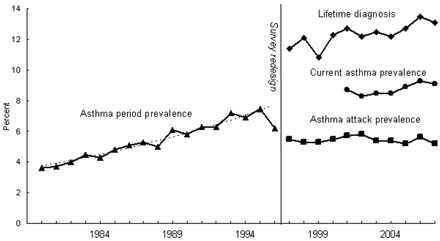What’s causing the spike in asthma rates?
This year, the U.S. Environmental Protection Agency is preparing to finalize new regulations tightening air quality standards for major pollutants like ozone. One of the main reasons why the EPA says we need these new rules is to reduce the number of cases of asthma. But are air pollution and asthma linked?
Let’s look at the numbers.
Here’s a chart from the EPA showing that ozone rates have fallen by 33 percent since 1980.
Now let’s look at asthma rates.
The U.S. Centers for Disease Control and Prevention National Center for Health Statistics has collected data on asthma since 1980, though in 1997 it changed its methodology. While data collected earlier can’t be accurately compared to rates since 2001, the CDC says “Asthma prevalence rates among children remain at historically high levels following dramatic increases from 1980 until the late 1990s.”
Status of Childhood Asthma in the United States, 1980–2007
Source: Lara J. Akinbami et al. Pediatrics 2009;123:S131-S145
In fact, developed countries began seeing a giant uptick in asthma cases in the 1980s—just as air quality started to improve. So will more stringent air regulations help bring those asthma rates down?
Maybe. Our understanding of the underlying factors that cause asthma is changing—as more research on asthma is done, the more complex its causes seem. Among the theories of asthma causes:
- Hygiene: A popular theory is that exposure to dirt and bacteria in early childhood actually helps protect against developing asthma. As countries have gotten cleaner, children have had less exposure to dirt, increasing their risk of developing asthma. This theory has been questioned, however, as newer evidence suggests dirt—like pollutants—may contribute to the development on nonallergic asthma.
- Childhood colds: Some evidence suggest that severe childhood colds can increase the risk of asthma.
- Sedentary lifestyle: Some researchers hypothesize that higher obesity rates and a more sedentary lifestyle can increase inflammation in the body, resulting in a higher risk of asthma.
- Bacteria changes: Studies have shown children who consume unpasteurized milk and lived on farms with livestock almost never develop asthma. Researchers have hypothesized that exposure to different bacteria may have a protective effect for those children.
- Smoking: Children of parents who smoke—especially when the mother smokes—have a significantly higher risk of developing asthma.
Rather than outdoor pollutants, indoor air pollutants have been identified as a likely culprit behind increased asthma rates. As allergist William E. Walsh, MD, FACC explains: “Fifty years ago we lived in old, drafty houses, and the breeze dried and freshened the air, and cleared out mold and other allergens. Nowadays, our super-insulated houses don’t breathe adequately. Making basements into a living space increases mold exposure because mold grows in any basement.”
A recent paper by researchers with Johns Hopkins Children’s Center suggested indoor air pollution, including secondhand smoke, rodents, mold, etc. is a risk factor for asthma. After studying over 23,000 U.S. children, the paper found no statistically significant difference in asthma rates between those who live in inner-city neighborhoods (exposed to higher levels of outdoor air pollution) and those who do not. Researchers found the greatest risk factor for developing childhood asthma is poverty.
In a research paper, The National Asthma Institute of Australia in conjunction with the Australian Government Department of Health and Ageing points out that “air pollution is often mistakenly thought to be a major environmental problem and a possible explanation for the high prevalence of asthma in Australia.”
There’s still so much we don’t know about the causes of asthma. But from what we do know, it seems unlikely dramatically reducing ozone levels will have an appreciable impact on new cases of asthma.


